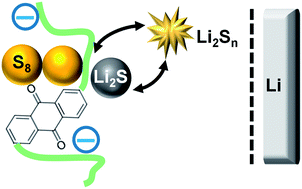当前位置:
X-MOL 学术
›
J. Mater. Chem. A
›
论文详情
Our official English website, www.x-mol.net, welcomes your
feedback! (Note: you will need to create a separate account there.)
Improved performance through tight coupling of redox cycles of sulfur and 2,6-polyanthraquinone in lithium–sulfur batteries
Journal of Materials Chemistry A ( IF 10.7 ) Pub Date : 2017-11-14 00:00:00 , DOI: 10.1039/c7ta08129d Ka-Cheong Lau 1, 2, 3, 4, 5 , Ilya A. Shkrob 1, 2, 3, 4, 5 , Nancy L. Dietz Rago 2, 3, 4, 5 , Justin G. Connell 1, 2, 3 , Daniel Phelan 2, 3, 5, 6 , Bin Hu 2, 3, 4, 5 , Lu Zhang 1, 2, 3, 4, 5 , Zhengcheng Zhang 1, 2, 3, 4, 5 , Chen Liao 1, 2, 3, 4, 5
Journal of Materials Chemistry A ( IF 10.7 ) Pub Date : 2017-11-14 00:00:00 , DOI: 10.1039/c7ta08129d Ka-Cheong Lau 1, 2, 3, 4, 5 , Ilya A. Shkrob 1, 2, 3, 4, 5 , Nancy L. Dietz Rago 2, 3, 4, 5 , Justin G. Connell 1, 2, 3 , Daniel Phelan 2, 3, 5, 6 , Bin Hu 2, 3, 4, 5 , Lu Zhang 1, 2, 3, 4, 5 , Zhengcheng Zhang 1, 2, 3, 4, 5 , Chen Liao 1, 2, 3, 4, 5
Affiliation

|
Lithium–sulfur (Li–S) batteries offer high theoretical capacity and energy density; however, complex nanoengineered cathodes have been required to suppress the unwanted polysulfide shuttling. The textural complexity of such electrodes hinders detailed understanding of their function, impeding the development of new materials. In this report, the redox-active polymer 2,6-polyanthraquinone (PAQ) was incorporated into the cathode. The presence of this polymer improves capacity retention in galvanostatic cycling and inhibits Li corrosion and S deposition. We show that redox reactions of this polymer are strongly coupled to the S redox cycle and hypothesize that the observed improvements in the performance originate from the electrocatalytic inhibition of polysulfide shuttling in this system.
中文翻译:

通过紧密耦合锂硫电池中硫和2,6-聚蒽醌的氧化还原循环来提高性能
锂硫(Li-S)电池具有很高的理论容量和能量密度。然而,需要复杂的纳米工程阴极来抑制多余的多硫化物穿梭。这种电极的结构复杂性妨碍了对其功能的详细了解,从而阻碍了新材料的开发。在该报告中,将氧化还原活性聚合物2,6-聚蒽醌(PAQ)掺入到阴极中。该聚合物的存在改善了恒电流循环中的容量保持能力,并抑制了Li腐蚀和S沉积。我们表明,该聚合物的氧化还原反应与S的氧化还原循环密切相关,并假设观察到的性能改善源自该系统中多硫化物穿梭的电催化抑制作用。
更新日期:2017-11-16
中文翻译:

通过紧密耦合锂硫电池中硫和2,6-聚蒽醌的氧化还原循环来提高性能
锂硫(Li-S)电池具有很高的理论容量和能量密度。然而,需要复杂的纳米工程阴极来抑制多余的多硫化物穿梭。这种电极的结构复杂性妨碍了对其功能的详细了解,从而阻碍了新材料的开发。在该报告中,将氧化还原活性聚合物2,6-聚蒽醌(PAQ)掺入到阴极中。该聚合物的存在改善了恒电流循环中的容量保持能力,并抑制了Li腐蚀和S沉积。我们表明,该聚合物的氧化还原反应与S的氧化还原循环密切相关,并假设观察到的性能改善源自该系统中多硫化物穿梭的电催化抑制作用。











































 京公网安备 11010802027423号
京公网安备 11010802027423号